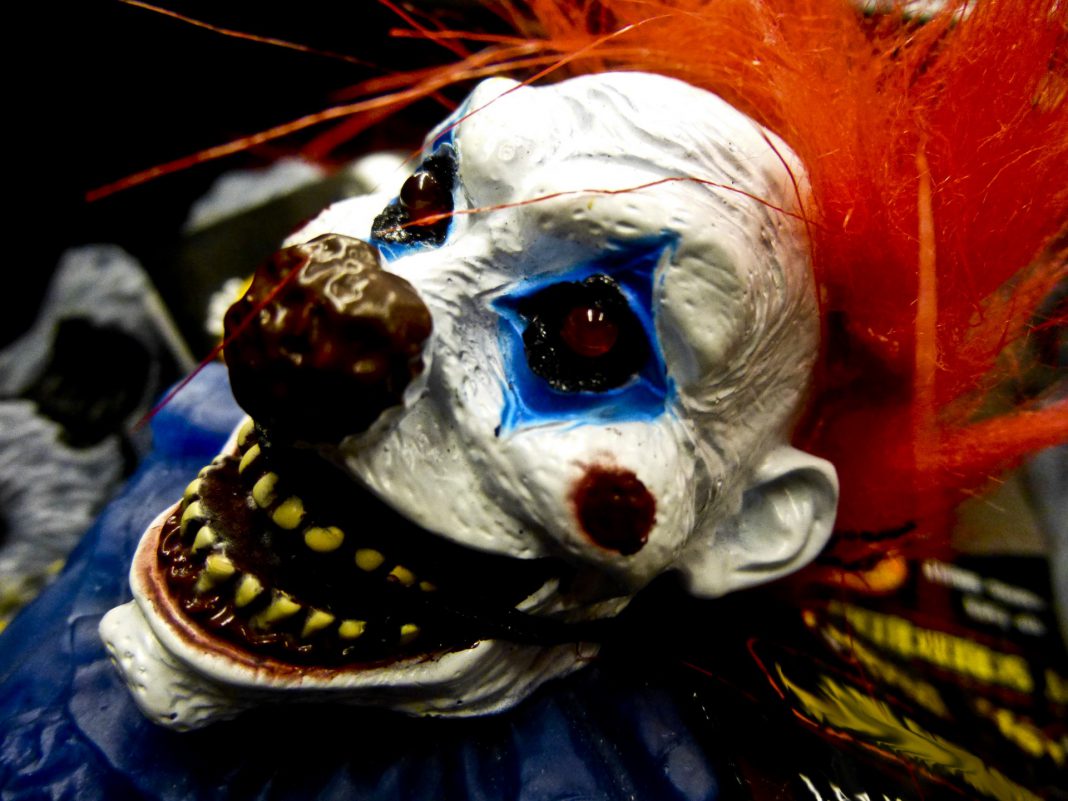EVANSVILLE—When it comes to clown performances, the world renowned duo of Mump and Smoot, aka Michael Kennard and Evansville’s John Turner, are pretty far from your typical children’s birthday party act, but the recent creepy clown craze has left the duo somewhat bemused. The Expositor contacted Mr. Turner for his views on the craze and what might be driving our social media preoccupation with the fad.
For those unaware of the creepy clown phenomenon, congratulations on your incredibly successful disengagement from the digital world with its plethora of memes and viral trending hysterias of the moment, let us fill you in.
A recent fad of dressing up in creepy clown (sometimes called ‘killer clown’) costume and frightening people (usually children) has, in the language of the Internet, gone viral. Purportedly first rising on the public radar earlier this year with sightings in South Carolina by children near an apartment complex, the fad appears to have taken on a life of its own and reports with varying levels of malevolence having taken place in over 20 states in the US and across Canada.
Tapping into the human primal fascination with all things scary, the creepy clown craze has caught on in a big way—leading to unnerving behaviour (in the case of clown-clad individuals attempting to lure children into wooded areas and other secluded places) and a number of arrests. Considering the US fascination (and ubiquity) of firearms it is amazing there have not yet been reports of shootings, but there has definitely been a violent backlash in some cases.
Caulrophobia is the clinical name for a fear of clowns, but that fear is most often more associated with the quality of the unknown that comes more from the anonymity provided by clown regalia than with the clowns or their actions.
Mr. Turner thinks that may well be the case.
“I know a successful children’s birthday party clown who arrives without makeup and in the first part of his performance the children watch him put on his makeup,” he said. “After that, the children all seem fine with it.”
Anyone who has experienced trying to capture a photograph of a young child on Santa’s knee will be familiar with the abject terror that the big red jolly guy can evoke in the younger set.
“We have had lots of people at our shows over the years (who have expressed a terror of clowns) but after they come to watch the show and leave, it doesn’t bother them,” noted Mr. Turner. One theatre professional considered leaving the theatre when she discovered that Mump and Smoot were perfectly capable of an impromptu visit to the lighting booth overhead during the course of their act. “She was happier after having met us and by the second show she was fine,” he recalled.
Much of the primal part of the equation comes from the power of the mask, suggests Mr. Turner. “It can be used to hide what is going on or to reveal what is going on,” he points out. “Ours is on the revealing side.”
As to the act of slipping in and out of the shadows in clown makeup and costume to see people’s reactions, Mr. Turner finds himself somewhat surprised by his own reaction. “I can totally get that,” he said.
Still, at the end of the day, what is going on with creepy clowns is essentially one dimensional and, dare we say it, somewhat lame. “They are not clowns,” emphasized Mr. Turner. “They are just idiots dressed up as clowns.”
The media, both social and traditional, have fed the creepy clowns all out of proportion to their worth. There does seem to be something special about the clown image that captures the puerile too often evident in the media. “If we were talking about people dressing up in doctor’s costumes and trying to lure people into the shadows, would we even be talking right now?” he asked. Doctors, after all, are at least as scary as clowns in real life interactions.
Actual clowns, the real deal, are serious professionals who spend years learning and honing their craft. It takes a lot more than a red nose and a bit of face paint a clown for to be. “We offer a 100-hour introductory course at the Manitoulin Conservatory for Creation and Performance (MCCP) (formerly The Clown Farm),” said Mr. Turner. “We have people who take a two-week course and then go out and try to put on a show.” It is not a recipe for success. “There are people who can go out and clown naturally,” he admits, “but most of us have to work hard at it. It takes self examination, digging into self to find the centre of your creativity.” Mr. Turner can point to concrete examples where, even with years of theatrical school training, attempting to successfully pull off a clown show after two weeks of courses has been a catastrophic flop.
That being said, Mr. Turner notes that it is a really unwise idea to put on a red nose and drive around scaring people. The power of anonymity can make people do stupid and silly things they would never consider without that mask. “It is just something about that mask, the act of being anonymous that enhances those tendencies,” he said. “You tend to do silly things you would never consider doing otherwise.”
There is also a lot of power to be found in masks, something that does tap into our primal instincts. “Most cultures invest a lot into masks,” he noted. His clown partner Michael Kennard has a vast mask collection, consisting of both masks they have created and those from around the world. Masks are a somewhat universal facet of most cultures and there is most often a power associated with the mask.
If the viewer knows that there is a familiar person behind the mask, the malevolence of the mask is muted. “It makes it an honest thing,” he said.
Mr. Turner said that he suspects the people behind the creepy clown masks really do not understand the power inherent in the mask. “They haven’t examined it,” he suggests.
While Mump and Smoot do utilize “scary” in their performances, the audience is prepared for that, it is part of the deal when they attend the show.
“We have rules,” he said. “There is an underlying understanding of the rules of engagement.”
With the creepy clown phenomena, that social contract is nonexistent, there is no agreement in place between clown and audience of what the rules are and how things will unfold in the interaction. That can have terrible consequences.
“I read in the news a story about three guys who jumped out of a car and started beating the clown,” he said. “It is amazing that no one has been shot.”
Like most fads, Mr. Turner said he anticipates that the current creepy clown craze will run its course in a short period of time. “Maybe something good will come out of it,” he quipped, “some kind of social movement.”
He noted that currently there are many beneficial and benevolent clown organizations and activities that far outweigh the handful of creepy clown experiences, but sadly get next to none of the media exposure. He cites the work of Clowns Without Borders, the adherents of the Patch Adams movement as examples.
Clowns Without Borders is an international non-profit organization which offers “resilience through laughter,” aiming to “relieve the suffering of all persons, especially children, who live in areas of crisis including refugee camps, conflict zones and other situations of adversity” by partnering “with individuals and organizations to bring small teams of professional performing artists to share performances and workshops with children and their families in refugee camps, conflict zones, or with communities who have experienced trauma or crisis.”
“Michael and I did a series of workshops in Israel at refugee camps in the Gaza in the 90s,” he recalled. “Some of the kids were quite frightened. They had never seen a North American before and they thought we all looked like that.”
As to what else is going on the world, Mr. Turner said he was fascinated with what is going on in the American election. “I take strong offence when people refer to Trump as a clown,” he said.
Thankfully, he notes, there is a growing supportive backlash to the creepy clown fad now coming from the professional clown community. “Clowns are starting to push back.”




